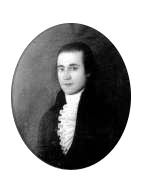
Peleg Arnold (1751–1820) was a lawyer, tavern-keeper, jurist, and statesman from Smithfield, Rhode Island. He represented Rhode Island as a delegate to the Continental Congress in the 1787–1788 session. He later served as the chief justice of the Rhode Island Supreme Court from June 1795 to June 1809, and from May 1810 to May 1812.

Elisha Reynolds Potter was a statesman in the Federalist Party from Kingston, Rhode Island, who served several times as the Speaker in the Rhode Island State Assembly.
These are tables of congressional delegations from Rhode Island to the United States Senate and United States House of Representatives.

James Burrill Jr. was a Federalist-party United States senator representing the state of Rhode Island. He served in the Senate from 1817 until 1820. He graduated from the College of Rhode Island and Providence Plantations at Providence in 1788.

The 1812–13 United States House of Representatives elections were held on various dates in various states between August 3, 1812, and April 30, 1813. Each state set its own date for its elections to the House of Representatives before the first session of the 13th United States Congress convened on May 24, 1813. They coincided with James Madison being re-elected president.

Barnabas Bidwell was an author, teacher and politician of the late 18th and early 19th centuries, active in Massachusetts and Upper Canada. Educated at Yale, he practised law in western Massachusetts and served as treasurer of Berkshire County. He served in the state legislature as representative and senator, as well as in the United States Congress as spokesman for the administration of Thomas Jefferson. He was effective in defending the administration's positions and passing important legislation. He resigned his seat in Congress in July 1807.

James Fenner was an American politician who served as a United States Senator as well as the 7th, 11th and 17th Governor of Rhode Island. He was the son of Arthur Fenner, the fourth governor of Rhode Island.
Benjamin Howland was a United States senator from Rhode Island. Born in Tiverton, he attended the common schools, engaged in agricultural pursuits, was collector of taxes in 1801, town auditor in 1802, and town moderator in 1805. He was a member of the Rhode Island House of Representatives in 1810 and a general in the State militia during the War of 1812.

David Thomas was an American politician. He served three full terms and one partial term in the United States House of Representatives (1801-1808), and three years as New York State Treasurer.

Isaac Wilbour was an American politician from Rhode Island holding several offices, including the sixth Governor of the state.

Henry Young Cranston was a U.S. Representative from Rhode Island, brother of Robert B. Cranston.

James Brown Mason was an American physician and legislator who served in the Rhode Island House of Representatives from 1804 to 1814, where he was speaker from 1812 to 1814. Elected to Congress in November 1814, he represented one of Rhode Island's two at-large congressional districts from 1815 until 1819.

The 1810–11 United States Senate elections were held on various dates in various states. As these U.S. Senate elections were prior to the ratification of the Seventeenth Amendment in 1913, senators were chosen by state legislatures. Senators were elected over a wide range of time throughout 1810 and 1811, and a seat may have been filled months late or remained vacant due to legislative deadlock. In these elections, terms were up for the senators in Class 2.

The 2016 United States House of Representatives elections in Rhode Island were held on November 8, 2016, to elect the two U.S. representatives from the state of Rhode Island, one from each of the state's 2 congressional districts. The elections coincided with the 2016 U.S. presidential election, as well as other elections to the House of Representatives, elections to the United States Senate and various state and local elections. The primaries took place on September 13.

The 2018 United States House of Representatives elections in Rhode Island were held on November 6, 2018, to elect the two U.S. representatives from the state of Rhode Island, one from each of the state's 2 congressional districts. The election coincided with the 2018 U.S. mid-term elections, as well as other elections to the House of Representatives, elections to the United States Senate and various state and local elections. The primaries took place on September 12.

The 2020 United States House of Representatives elections in Rhode Island was held on November 3, 2020 to elect the two U.S. representatives from the state of Rhode Island, one from each of the state's 2 congressional districts. The elections will coincide with the 2020 U.S. presidential election, as well as other elections to the House of Representatives, elections to the United States Senate and various state and local elections.
United States gubernatorial elections were held in 1810, in 13 states, concurrent with the House and Senate elections.

The 1810 Connecticut gubernatorial election took place on April 9, 1810.

The 2022 Rhode Island House of Representatives elections took place on November 8, 2022. Primary elections were held on September 13, 2022. Rhode Island voters elected state representatives in all 75 seats of the House of Representatives to serve two-year terms.
















